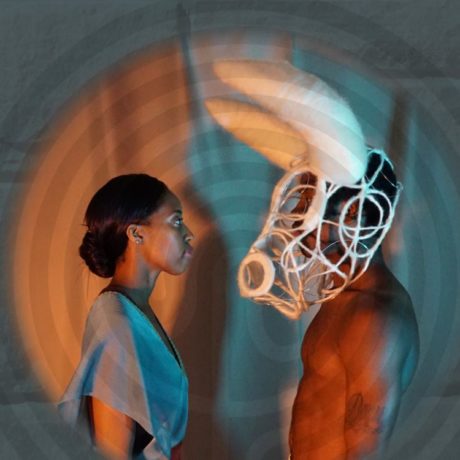Hypnotic, transportive, and exquisitely beautiful, Mistress of the Maze marks the unforgettable debut of WeftWorks with its stunning world-premiere performance in the 2017 Fringe. Created, choreographed, and designed by Sarah Carr – an exceptionally gifted multi-disciplinary artist and recent transplant to Philadelphia, who launched the project earlier this year – the original work showcases her training in dance, skill in fiber arts, and expertise in anthropology, with a focus on the archaeology of the pre-Greek Minoan culture that flourished in the Aegean Bronze Age from the 3rd to the 2nd millennium BC.

Examining the origins of the Minotaur (the half-man/half-bull beast of King Minos of Crete) and the Labyrinth in which he was kept (as later recorded in ancient Greek mythology), Carr’s gynocentric interpretation features three female dancers (Meli’sa Grier, Caitlin Green, and Shelby Tucker) in the roles of the legendary Priestesses, Goddesses, and Genii, and one male (Neimyiah Whittley), who appears as both the Sacred Bull and Theseus (the heroic protagonist who killed him). Presented in fourteen short segments, the piece is performed to a reverberating soundscape of soulful Anatolian music that sets the locale in the Near East and creates a haunting otherworldly tone. The transcendent dreamlike mood of the recorded score is reinforced by the masterful dancers, whose slow ritualistic movements invoke a sense of mystery and gravitas. All bring consummate grace, balance, refinement, and control to their solo performances, and exhibit flawless partnering and synchronization in their sequences with each other.
Carr’s choreography is based in the light, elegant, fluid movements of classical ballet (at which the dancers are expert), but also astutely references the postures, gestures, and situations of figures from the murals, seals, and sculptures of ancient Minoan art (such as the upraised arms, bent at the elbows, of the faience figurine of the Snake Goddess, and the actions depicted in the Bull-Leaping Fresco, both from the Palace of Knossos on Crete). Those are interspersed with occasional angular flexes of the feet and hands that recall the traditional folk dances of the region and make surprising breaks from the predominantly smooth balletic extensions. Handmade masks, props, and costumes by the multi-talented Carr also take their inspiration from extant Minoan art, imagery, and iconography (including the ceremonial double axe or labrys and the horned head of the Minotaur), with the fiber arts woven into the production smartly recalling the spool of thread given to Theseus by Ariadne (King Minos’ daughter and the titular character of the show), so that he could mark his way out of the maze. But then everything about this dance/theater/art piece is brilliant.
My only regret about WeftWorks’ Mistress of the Maze is that it only ran for two days and three performances, so more Fringe-goers weren’t able to see it. We should all look forward to future presentations of this outstanding work and company.

Running Time: Approximately 35 minutes, without intermission.
Mistress of the Maze played Saturday and Sunday, September 16-17, 2017, at WeftWorks, performing at CHI Movements Art Center – 1316 South 9th Street, Philadelphia, PA.




